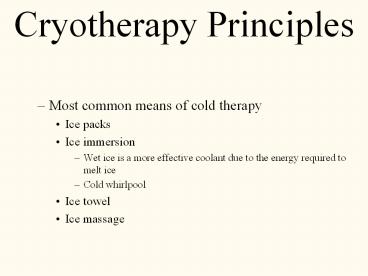Most common means of cold therapy - PowerPoint PPT Presentation
Title:
Most common means of cold therapy
Description:
... the genitals To the abdomen during pregnancy When there are signs of acute inflammation Dry Heat Moist Heat Therapies Moist Heat Packs Whirlpool Ultrasound ... – PowerPoint PPT presentation
Number of Views:117
Avg rating:3.0/5.0
Title: Most common means of cold therapy
1
Cryotherapy Principles
- Most common means of cold therapy
- Ice packs
- Ice immersion
- Wet ice is a more effective coolant due to the
energy required to melt ice - Cold whirlpool
- Ice towel
- Ice massage
2
- Physiological Principles
- Vasoconstriction
- Decreases extent of secondary tissue death
- Decreases cell metabolic rate
- Decreases the need for oxygen
- Results in less tissue damage
- Decreased swelling from inflammatory response
- Decreases muscle spasm
- Decreases pain
- Cold is more penetrating than heat
- Decreases muscle fatigue
3
- Special Considerations
- Avoid overcooling
- Some individuals are allergic to cold and react
with - Hives
- Joint pain
- Special medical conditions ice is contraindicated
- Application of ice (very rare) can cause nerve
damage - Be cautious with return to activity following
icing - Stop cryotherapy for any of the above
complications or side effects - Icing through a towel or bandage
- Limits the reduction in temperature
- Could limit effectiveness of treatment
4
- Cold Response
- Burning
- Aching
- Numbness
- Analgesia (pain is relieved)
- Athlete can engage in rehab activities
- Special considerations
- Keep in mind comfort of the athlete during
treatment
5
Cryotherapy Techniques
- Ice Massage
- Cold or Ice Water Immersion
- Temperature 50º to 60º
- Ice Packs (Bags)
- Chemical Cold packs
- Vasocoolant Sprays
6
Transmission of Thermal Energy
- Temperatures of
- 116.6o F will cause tissue damage and
temperatures - 113o F should not be on the skin longer than 30
min.
7
Thermotherapy
- Physiological Effects of Superficial Heat
- Dependent on type of heat energy applied
- Intensity of heat energy
- Duration of exposure
- Desired effects
- Increase soft tissue flexibility
- Decreasing joint stiffness
- Reducing pain
- Relieving muscle spasm
- Reduction of edema and swelling
- Increasing blood flow
- Pain relief
- Gate control mechanism
- Secretion of endorphins to block pain
8
- Special considerations
- Never apply heat
- When there is loss of sensation
- Immediately after injury
- When there is decreased arterial circulation
- Directly to eyes or the genitals
- To the abdomen during pregnancy
- When there are signs of acute inflammation
- Dry Heat
- Moist Heat Therapies
- Moist Heat Packs
- Whirlpool
- Ultrasound
9
- Contrast (Alternating Cold and Heat)
- Equipment
- Hot and cold tubs/whirlpools
- Hot and cold packs
- Indications
- Transition from cold to heat
- Minimal temperature changes occur superficially
- Application
- Treatment ratio used
- Move from primarily cold to heat
- Water temperature should be kept constant
- Athlete should be comfortable































